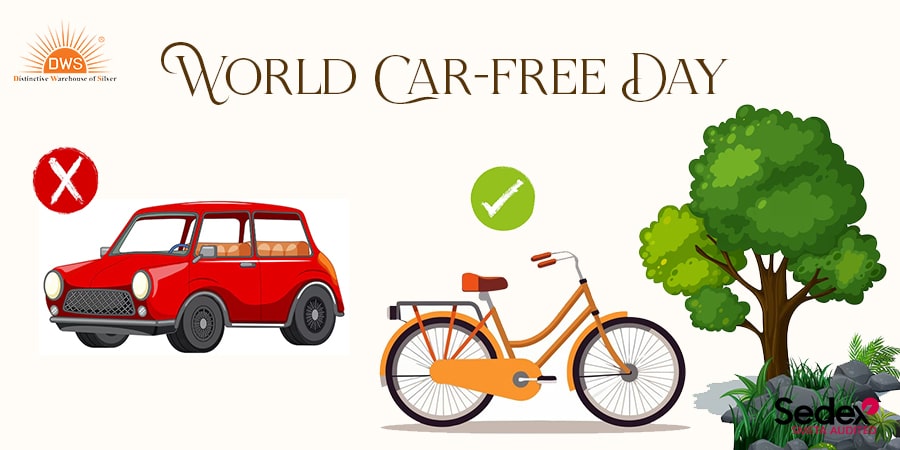- Written By Team DWS
- Festivals
- August 03, 2025
Car-Free Day: Reimagining Our Cities, Health, and Future
Every September 22, cities across the globe transform as Car-Free Day invites us all to pause, reflect, and experience our urban spaces without the dominance of cars. What began as a response to oil shortages decades ago has evolved into a powerful, symbolic movement—one that highlights the urgent need for sustainable cities, cleaner air, and healthier communities. In this long-form blog post, we explore the origins, impact, and future of Car-Free Day, taking you on a journey through history, across continents, and into the heart of urban transformation.

The Origins: From Oil Crisis to Global Movement
Early Experiments: Necessity Breeds Innovation
The roots of Car-Free Day trace back to the energy crises of the 1970s. During the 1973 oil embargo, countries like the Netherlands and Belgium initiated car-free Sundays out of necessity, aiming to conserve fuel and reduce reliance on foreign oil supplies. These early experiments, characterized by empty city centers and people reclaiming the streets for walking and cycling, provided an unexpected glimpse into a world less dominated by cars.
The Birth of a Day
It wasn’t until the 1990s that the car-free movement gained structure and international momentum. Inspired by growing concerns around congestion, air pollution, and urban liveability, activists, urban planners, and policymakers began organizing more frequent, intentional car-free events. By 2000, the European Commission formally launched a Europe-wide Car-Free Day campaign, and September 22 was designated as World Car-Free Day—a date that now sees participation from over 2,000 cities worldwide.
Why Car-Free Day Matters
Air Quality and Climate Change
Cars remain one of the largest contributors to urban air pollution and climate change. Internal combustion engines discharge not only carbon dioxide (CO₂) but also nitrogen oxides and harmful particulate matter (PM2.5), all of which have grave implications for both the environment and human health. In 2023, road vehicles were responsible for about 3.5 billion metric tons of CO₂ emissions globally—half the emissions from the transportation sector and a tenth of all fossil fuel emissions.
Car-Free Day is not just a symbolic gesture; it showcases what cities could look and feel like with drastically reduced car usage. Measurements from London and Paris on Car-Free Day have shown nitrogen dioxide emissions dropping by as much as 60% in central areas, providing real-world evidence of the cleaner air we could achieve.
Human Health and Well-Being
Car-centric cities foster sedentary lifestyles, noise pollution, and a sense of alienation. Air pollution from vehicles is linked to millions of premature deaths each year, especially among children and vulnerable populations living near busy roads. Reducing road traffic accidents, respiratory illnesses, and even alleviating risks of dementia are among the measurable health benefits when cities limit car use, even for a single day.
Urban Space, Equity, and Community
Car-Free Day reopens public spaces typically devoted to vehicles, enabling pop-up parks, markets, art installations, sports, and cultural events. Streets, usually perceived as thoroughfares to be crossed or avoided, become vibrant places for gathering, play, and creativity. This temporary transformation challenges us to rethink who cities are for and whose voices shape urban design.
How Cities Celebrate: Global Highlights
Bogotá: A Blueprint for Latin America
Since 2000, Bogotá, Colombia has led the way in Latin America by turning its city-wide Car-Free Day into a logistical and cultural feat. Schools, businesses, and citizens get involved, and nearly 1.5 million cars are kept off the streets for the day. The initiative has not only reduced emissions by thousands of tons each year but fostered a powerful sense of civic pride and collective action.
Europe: Urban Centers as Living Labs
London, Paris, Amsterdam, and Barcelona have all experimented with large-scale road closures, public transport incentives, and open-air cultural events. In London, 12.3 miles of roads have been closed during Car-Free Day, encouraging citizens to cycle, walk, or simply “reimagine” public space. Paris has used Car-Free Day and pedestrian Sundays to push forward its broader vision of a “15-minute city,” where all daily needs can be met within a short walk or bike ride.
Asia: A Mosaic of Urban Innovation
Jakarta holds weekly car-free mornings on major avenues, drawing tens of thousands for walking, cycling, and yoga. Kaohsiung, Taiwan, makes public transport free for a week, and cities across Japan and China periodically restrict vehicle access as a demonstration of “living streets”.
Local Participation and Creativity
Community involvement is the hallmark of successful Car-Free Days. Activities range from art competitions and outdoor dance events to public chess games and spontaneous street performances. Local organizations, including cycling groups, schools, and businesses, often collaborate to create informative fairs, sustainability workshops, and even “Reclaim the Streets” flash mobs.
Lasting Impacts: Beyond One Day
Emission Reductions and Data Insights
Air quality monitoring during Car-Free Days consistently reveals how traffic contributes directly to urban smog. For instance, London’s Regent Street saw a 60% drop in nitrogen dioxide during the event, while Paris recorded 45% lower emissions in some streets compared to a regular Sunday. These snapshots give credence to policy measures like low-emissions zones, congestion charges, and car bans that many cities are increasingly adopting year-round.
Changing Attitudes and Urban Planning
Perhaps the most profound impact of Car-Free Day is the shift in mindset. Participants often report feeling happier, more relaxed, and “reconnected” with their city when cars are absent. Urban planners use these events as living laboratories to test policies—creating pop-up bike lanes, expanding pedestrian plazas, or experimenting with new public transit routes.
Car-Free Days also demonstrate pathways toward greater equality by making streets accessible to everyone. This spirit of inclusivity can inform broader efforts to design accessible, people-first cities.
Policy Catalysts
Car-Free Days serve as policy catalysts, prompting municipalities to commit to permanent improvements—expanded sidewalks, better cycling infrastructure, cleaner buses, and safer streets for all. Cities like Milan and Paris have moved towards banning cars from city centers in the coming years, and London’s Ultra Low Emission Zone has slashed roadside air pollutants by half since 2019.
How to Get Involved: Ideas for Cities, Communities, and Individuals
For City Governments
- Select car-free zones and times: Choose whole city centers or specific high-traffic districts; weekends or weekday rush hours can have different impacts.
- Engage stakeholders: Involve local businesses, schools, transport operators, resident associations, and civic groups early and consistently.
- Plan events: Host street fairs, fitness classes, art workshops, food markets, or music festivals—make the day fun and inclusive.
- Communicate and educate: Provide clear information to motorists, ensure alternative parking and transport, and use the event to promote sustainable mobility all year.
For Community Organizations
- Organize pop-up events: Host games, sports, or art competitions in newly car-free spaces.
- Advocate for policy change: Use data and stories from Car-Free Day to push for lasting improvements in transport and air quality.
- Educate and inspire: Share testimonials, photos, and video reels to broaden support.
For Individuals
- Pledge to go car-free: Walk, bike, use public transport, or share rides not just on Car-Free Day, but whenever possible.
- Celebrate with friends or colleagues: Attend local events, or host your own “car-free picnic” or outdoor gathering.
- Reflect on your city: Notice how the absence of cars changes your sensory experience—and imagine what more permanent changes could mean for your quality of life.
Looking Toward a Car-Lite Future
Car-Free Day is, ultimately, both a celebration and a challenge—a chance to experience city living at its most human scale, and a call to imagine healthier, greener, more equitable communities for everyone. The lessons learned during this single day can inspire cities and citizens alike to pursue permanent changes: better bike infrastructure, improved public transit, safer streets for children, and air fit to breathe.
As our world continues to urbanize, and as climate targets become ever more pressing, Car-Free Day’s message grows more urgent. It is a gentle, joyful, but determined reminder that our streets belong not just to cars, but to all of us.
So mark your calendar for September 22, and join millions worldwide in reclaiming the city for people—on foot, on bike, or any way you like that doesn’t require four wheels and a tailpipe. Your lungs, your neighbors, and your planet will thank you.

Author’s Note:
This blog post draws on the stories of diverse cities and communities to showcase Car-Free Day’s history and impact. Whether you’re stepping out in Bogotá, cycling in London, or celebrating in your own neighborhood, know that every Car-Free Day is part of a larger movement—one step at a time, toward cleaner, friendlier, more sustainable cities for all.
Popular on Blogs

Black Tourmaline: Meaning, Healing Properties, Fascinating Facts, Powerful Attributes, Versatile Uses, and Beyond
September 05, 2023 / BY Team DWS
Black Tourmaline, also known as Schorl, is a highly revered crystal with incredible metaphysical properties. It derives its name from the Dutch word "turamali," meaning "stone with ..

Carnelian Stone: Meaning, Healing Properties, Power, Facts, Color, Uses and More
December 26, 2023 / BY Team DWS
Carnelian is a vibrant and captivating gemstone that holds a plethora of meanings, healing properties, and powers. Its warm and fiery energy makes it a popular choice among crystal ..

Citrine: Exploring its Meaning, Healing Properties, Fascinating Facts, Powers, Versatile Uses, and Much More
November 18, 2023 / BY Team DWS
Citrine, with its warm golden hues, has captured the attention and imagination of people for centuries. This beautiful gemstone, commonly associated with wealth and prosperity, hol ..

Black Onyx: Unveiling the Meaning, Healing Properties, Fascinating Facts, Powerful Attributes, Versatile Uses, and Beyond
July 25, 2023 / BY Team DWS
Black Onyx, a striking gemstone admired for its deep black hue and elegant appearance, has captivated people for centuries. In this comprehensive guide, we will delve into the mean ..

Unveiling the Mysteries of Turquoise Stone: Exploring its Meaning, Healing Properties, Power, Facts, Color, Uses, and More
December 05, 2023 / BY Team DWS
Turquoise, with its captivating blue-green hue, has been adorning jewelry and artifacts for centuries. This striking stone has a rich history, rich symbolism, and a plethora of int ..

The History Behind The Popularity of Red Agate
December 23, 2022 / BY Team DWS
An Agate is a type of magma rock that takes many years till it is washed out naturally into the water. And that is the reason this stone has elements of water. This beautiful stone ..

Bloodstone: Unveiling the Meaning, Healing Properties, Facts, Powers, Uses, and More
August 21, 2023 / BY Team DWS
Bloodstone, with its captivating deep green color with specks of red, is a mesmerizing gemstone that has fascinated civilizations for centuries. It possesses unique healing propert ..

Plan a Perfect Valentine's Week with Our Valentine Week List 2025
January 22, 2024 / BY Team DWS
Valentine's Day is undoubtedly the most romantic day of the year, but we believe that one day is just not enough to express your love and make your partner feel special. That's why ..


